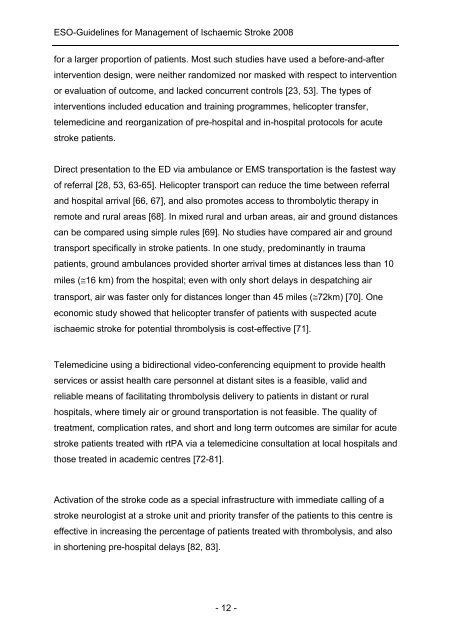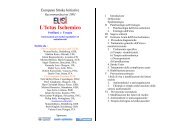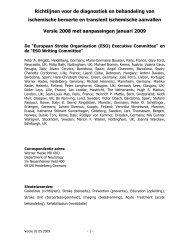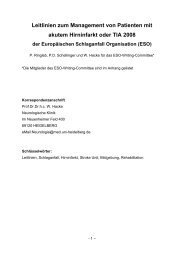Guidelines for Management of Ischaemic Stroke 2008 - ESO
Guidelines for Management of Ischaemic Stroke 2008 - ESO
Guidelines for Management of Ischaemic Stroke 2008 - ESO
Create successful ePaper yourself
Turn your PDF publications into a flip-book with our unique Google optimized e-Paper software.
<strong>ESO</strong>-<strong>Guidelines</strong> <strong>for</strong> <strong>Management</strong> <strong>of</strong> <strong>Ischaemic</strong> <strong>Stroke</strong> <strong>2008</strong><br />
<strong>for</strong> a larger proportion <strong>of</strong> patients. Most such studies have used a be<strong>for</strong>e-and-after<br />
intervention design, were neither randomized nor masked with respect to intervention<br />
or evaluation <strong>of</strong> outcome, and lacked concurrent controls [23, 53]. The types <strong>of</strong><br />
interventions included education and training programmes, helicopter transfer,<br />
telemedicine and reorganization <strong>of</strong> pre-hospital and in-hospital protocols <strong>for</strong> acute<br />
stroke patients.<br />
Direct presentation to the ED via ambulance or EMS transportation is the fastest way<br />
<strong>of</strong> referral [28, 53, 63-65]. Helicopter transport can reduce the time between referral<br />
and hospital arrival [66, 67], and also promotes access to thrombolytic therapy in<br />
remote and rural areas [68]. In mixed rural and urban areas, air and ground distances<br />
can be compared using simple rules [69]. No studies have compared air and ground<br />
transport specifically in stroke patients. In one study, predominantly in trauma<br />
patients, ground ambulances provided shorter arrival times at distances less than 10<br />
miles (≅16 km) from the hospital; even with only short delays in despatching air<br />
transport, air was faster only <strong>for</strong> distances longer than 45 miles (≅72km) [70]. One<br />
economic study showed that helicopter transfer <strong>of</strong> patients with suspected acute<br />
ischaemic stroke <strong>for</strong> potential thrombolysis is cost-effective [71].<br />
Telemedicine using a bidirectional video-conferencing equipment to provide health<br />
services or assist health care personnel at distant sites is a feasible, valid and<br />
reliable means <strong>of</strong> facilitating thrombolysis delivery to patients in distant or rural<br />
hospitals, where timely air or ground transportation is not feasible. The quality <strong>of</strong><br />
treatment, complication rates, and short and long term outcomes are similar <strong>for</strong> acute<br />
stroke patients treated with rtPA via a telemedicine consultation at local hospitals and<br />
those treated in academic centres [72-81].<br />
Activation <strong>of</strong> the stroke code as a special infrastructure with immediate calling <strong>of</strong> a<br />
stroke neurologist at a stroke unit and priority transfer <strong>of</strong> the patients to this centre is<br />
effective in increasing the percentage <strong>of</strong> patients treated with thrombolysis, and also<br />
in shortening pre-hospital delays [82, 83].<br />
- 12 -





